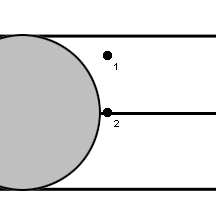MORE Basics:
What is a total solar eclipse?
Here are some truly fantastic animations, provided by Ernie Wright of NASA, that give wonderful VISUAL explanations of the eclipse:
(Please be patient, as they take a second to load!)
Overview of the shadow passing over the USA
A "Moon's-eye" view of the eclipse!
You can see the Earth rotating during the eclipse; the Moon is also moving in its orbit, but you don't see that because you're traveling along with it!
A scale model of the Moon's shadow cutting across the surface of the Earth!
This one is our favorite, because it shows you the true scale of the eclipse, and how amazing it is to be a part of this cosmic alignment!
Here is perhaps the greatest eclipse photograph ever created.
It is a composite of many many exposures
combined digitally by the master Miloslav Druckmüller.
It is honestly as close as a picture
can be to the full effect of what you see (though you don't see so many stars!).
Please note how this doesn't look like ANY other eclipse photo you've likely seen!
There is a lot of
good eclipse information out there, that we can't really add a lot to.
Digest the info on the sites below, and you'll understand quite a bit about eclipses!
· Here is a great animation to show you how the moon's
shadow traces out a path along the earth's surface. With this, you can see
why (a) the path on the earth's surface that you have to be in is so
small, and (b) why you have to be in that path in order to see the whole
sun blocked by the moon (a TOTAL solar eclipse).
· Here is a
page that has a narrative description of what an eclipse is.
· Another wonderful site with descriptions and
animations.
· Yet another site with a quick but nice description of what
you see during an eclipse.
· A cool animation of the moon's shadow racing across the earth
in 2006, as seen from a satellite in orbit!
· Another site from South Africa with lots of good eclipse information!
·
Fred Espenak is truly 'Mr. Eclipse', and here
is his site for beginners!
· Here's a site with a little more technical
bent.
· A great site by Xavier Jubier
·
And a wonderful article in Nature by noted eclipse chaser Jay Pasachoff
|
And there are a lot more great sites out there!
|
OK, so now you know what causes an eclipse, and you're
ready to go to the maps to see if you can see totality from where you
live. (If not, then please get on down the road and find a spot that's
within the shadow!)
But first, some answers to questions you may
have: |
I've looked at the maps, and read the
narrative of the path's travels
over the United States. If the path of totality goes over all these cities
from Oregon to South Carolina, then why doesn't every place in the path get the
same amount of totality?
We've put together an animation (greatly exaggerated!) to explain this -- go here to see it.
There are a couple of things going on. First, as the shadow passes over the earth, the earth's curvature causes
observers farther away from the midpoint of the eclipse path (near Hopkinsville,
KY for the 2017 eclipse) to be farther away from the moon. This makes the moon
look smaller, so it takes less time for it to pass across the face of the sun.
The other way to look at this is that these observers are in a part of the
shadow cone where its cross-section is smaller. Again, less shadow to be in. But
second, the shadow moves across the earth faster as we get closer to the ends of
the path. These two effects combine to produce less totality at the centerline
(and at other corresponding points within the path) nearer the path's
ends.
I know why I have to be in the path of totality to see
a total eclipse, but I don't get why I need to be near the
centerline.
You will want to see as much totality as possible -
every second counts when you're confronted with this magnificent a sight! The
reason you need to be near the centerline to get as much totality as possible is
simple geometry. The shadow is an oval, but we can get away with calling it a
circle for the sake of discussion. (The same statements apply to ellipses as well as circles, but the math - and the animations - are much more
complicated!)
Look at the animation below. This is the outline of the shadow of the moon
traveling over the surface of the earth at a particular spot. You can see
that observer #2 at the centerline is getting to be in the shadow more than
observer #1 (closer to the edge of the path), simply because the diameter of the
circle is longer than the chord of the circle that passes over an
observer like #1 - who chose not to be on centerline!

True, this effect is rather slight until you get right to the edge (where the
time of totality falls off dramatically), but it will still account for more
than a few seconds of time lost in the shadow!
Now after having said all
that, there are indeed some good reasons for wanting to be close to the edge - you get
beautiful effects during the entire eclipse (although it is shorter). In
fact, we will be setting up some experiments using viewers stationed along the
path edges. But if all you want to do is look, or if this is your first eclipse, then try to get to the
centerline. Whatever you do, though, make sure you're IN THE PATH!




